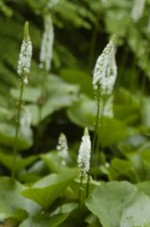 Also called beetleweed, this evergreen herbaceous perennial is native to southeastern US from where it grows in the forests of the southern Appalachian Mountains, Piedmont, and Coastal Plain. It is a member of the Diapensiaceae family, a small family of only twelve species. The plants have red rhizomes that spread to form colonies with basal rosettes of foliage consisting of shiny, leathery green leaves that become tinged with bronze in the winter. The heart shaped leaves are five inches across, have round toothed margins, and are carried on long petioles. The tiny five lobed white flowers are produced from late spring to early summer in two to five inch long spike-shaped racemes on top of slender stems eight to sixteen inches long. The leaves are very attractive in flower arrangements and have been over-harvested in some areas for the floral industry. A good choice for a ground cover in a shady location. The generic name, Galax, comes from the Greek word gala meaning milk and may refer to the white flowers. The specific epithet, urceolata, is the diminutive of the Latin word urceus, meaning pitcher.
Also called beetleweed, this evergreen herbaceous perennial is native to southeastern US from where it grows in the forests of the southern Appalachian Mountains, Piedmont, and Coastal Plain. It is a member of the Diapensiaceae family, a small family of only twelve species. The plants have red rhizomes that spread to form colonies with basal rosettes of foliage consisting of shiny, leathery green leaves that become tinged with bronze in the winter. The heart shaped leaves are five inches across, have round toothed margins, and are carried on long petioles. The tiny five lobed white flowers are produced from late spring to early summer in two to five inch long spike-shaped racemes on top of slender stems eight to sixteen inches long. The leaves are very attractive in flower arrangements and have been over-harvested in some areas for the floral industry. A good choice for a ground cover in a shady location. The generic name, Galax, comes from the Greek word gala meaning milk and may refer to the white flowers. The specific epithet, urceolata, is the diminutive of the Latin word urceus, meaning pitcher.
Type: Evergreen herbaceous perennial
Bloom: Two to five inch long spike-like racemes of tiny white flowers on eight to sixteen long slender stems from late spring to early summer
Size: Leaves 3-6” H , flower stalks 12-18” H x 12” W
Light: Partial to full shade
Soil: Fertile, moist, well-drained, acidic
Hardiness: Zones 5-8
Care: Low maintenance; mulch to maintain consistent soil moisture
Pests and Diseases: Anthracnose, sooty mold, snails, slugs
Propagation: Divisionin late spring to early summer, fresh seed, softwood cuttings in summer
Companion Plants: Virgina bluebells, Trillium, lungwort (Pulmonaria), Dicentra exima, ferns, hosta